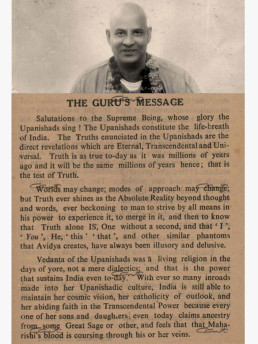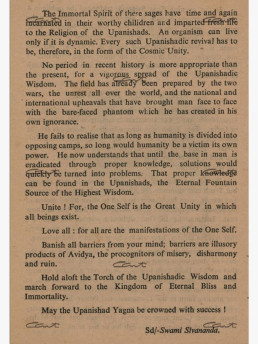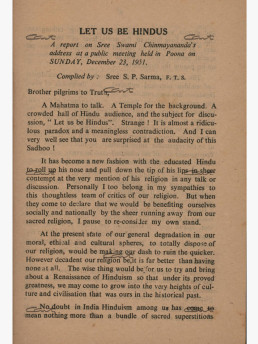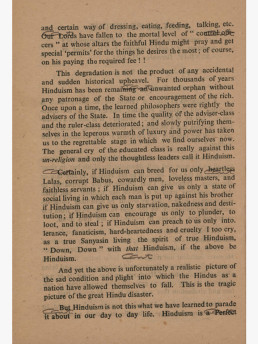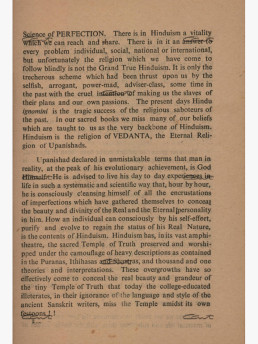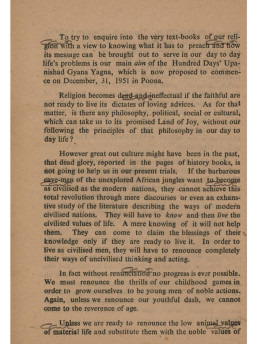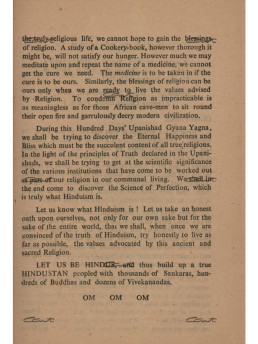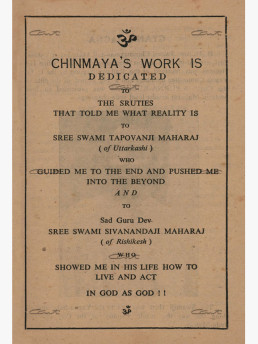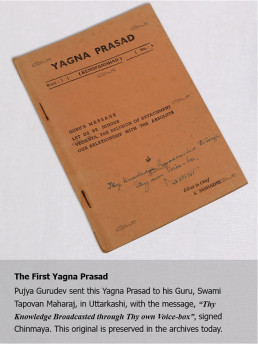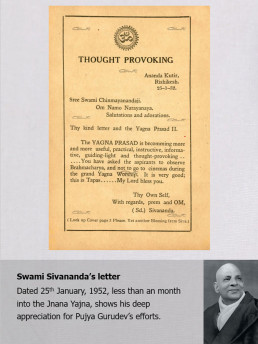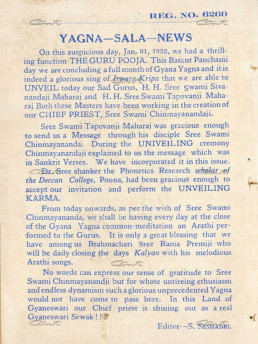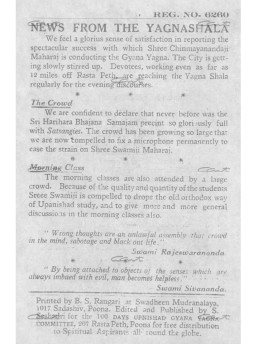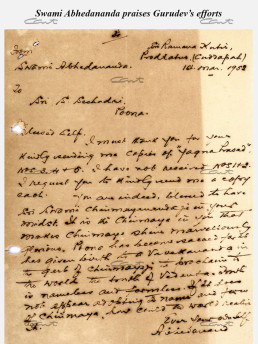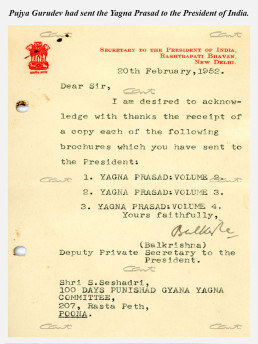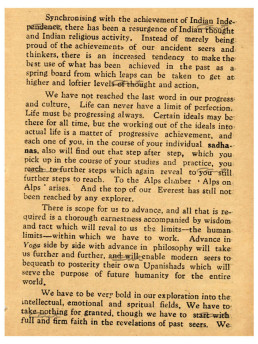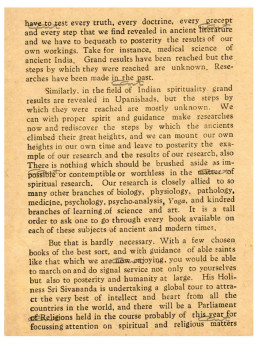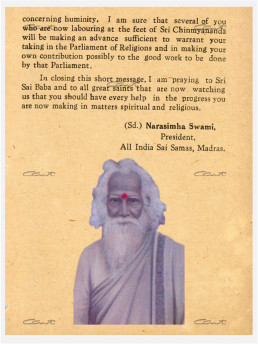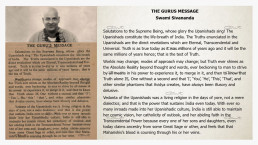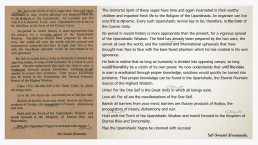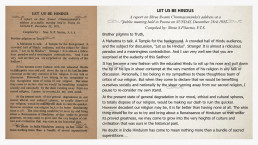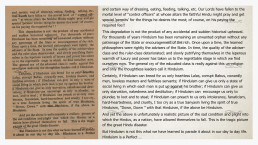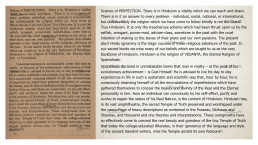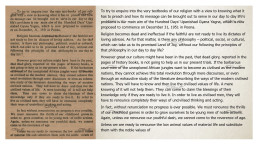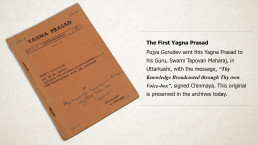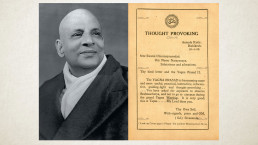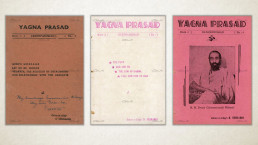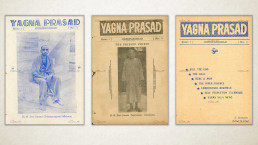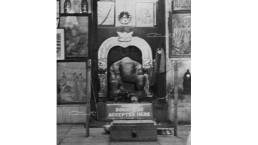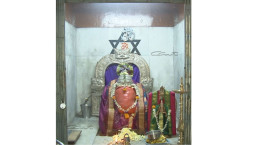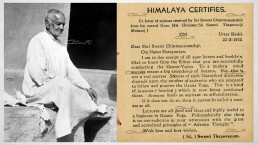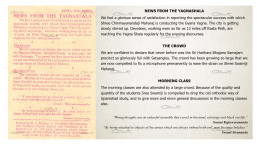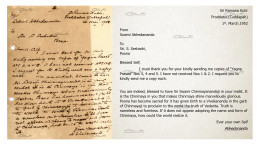It was December 1951. A young Swami Chinmayananda was ready to launch the first Jnana Yagna, the forerunner of many more to come, and which was to eventually burst forth and grow into the huge tree of Chinmaya Mission. This short video tells us the story.
CHINMAYA’S PRAYER TO HIS GURU
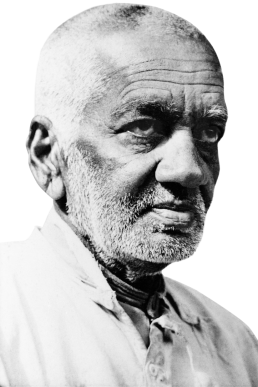
A recently discovered letter by Pujya Gurudev reveals a very moving poem addressed to his Guru, Swami Tapovanam, on the occasion of the Guru Purnima in 1968. Having attained supreme Bliss with the guidance of his Guru, he yearns to pass it on to others. It is this yearning which led him to start the first jnana yajna.
PUJYA GURUDEV ARRIVES IN PUNE

It was a small step from the train to the railway platform, but a momentous and historic event in the annals of Chinmaya Mission, when Pujya Gurudev Swami Chinmayananda stepped out of the train on 23rd of December 1951 and set foot on the punya bhumi (holy land) of Pune. He was received by a big gathering of the important citizens of the city, headed by the Yajna Committee, with Vedic chants and purna kumbham. He had arrived with the whole-hearted blessings of Swami Sivananda and the reluctant blessings of Swami Tapovan Maharaj.
LECTURES HERALDING THE YAJNA
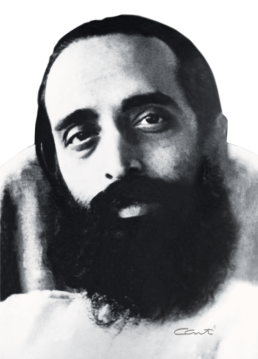
A lot of work had already been done to create public awareness through newspapers, pamphlets, letters and by word of mouth. All these culminated in a series of public lectures in Pune in the week before the inauguration of the yajna. On the 23rd, Swamiji delivered a lecture on the topic ‘Let Us be Hindus’. He talked on ‘What is Religion’ in the Deccan College Estate on the 25th and on ‘Vedanta – The Religion of Detachment’ on the 26th in yet another venue. On the 30th, in the Kirkee branch of the Divine Life Society, he lectured on ‘Our Relationship with the Absolute’. The gist of these talks were published in the form of articles in the very first yajna prasad booklet that was brought out. Except for the first of these, which can be seen below, all the others were included as a part of the introduction to the commentary on Kenopanishad, compiled from the yajna prasad booklets, available as a book today.
BIRTH OF THE JNANA YAJNA

In those days, yajna meant the long traditional havans, the elaborate fire rituals, and yajna prasad meant either the edible offerings sanctified in the ritual or the residual ashes of the fire itself. In this epoch-making event, Pujya Gurudev transformed the whole thing and raised it to a different plane altogether. Taking the cue from the Bhagavad Gita which mentions it, he brought alive the jnana yajna, where the fire of spiritual knowledge is kindled and our primal ignorance burnt forever. And the gist of the talks in printed form was offered as yajna prasad. The true prasad would be the knowledge, peace and bliss that descends on the heart of the devotee.
IMPORTANCE OF YAJNA PRASAD
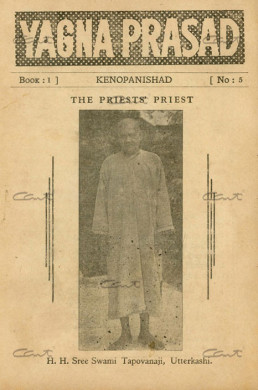
“Upanishad Yagna, lectures and pamphlet distribution – immediate reproduction of the lecture – this is a unique feature – unprecedented in the annals of Indian history. May Lord bless you all.” Thus wrote Swami Sivananda Maharaj from Rishikesh on February 1st. Gurudev had planned it all beforehand.
Pujya Gurudev sent the first copy of the first yajna prasad to his own Guru, Swami Tapovan Maharaj, in Uttarkashi, with the message, “Thy Knowledge Broadcasted through Thy own Voice-box”, signed Chinmaya. He was merely the instrument to spread the vital message of Vedanta. This first copy is preserved carefully in Chinmaya Archives. A total of six numbers on Kenopanishad were published at this time.
THE YAJNASHALA
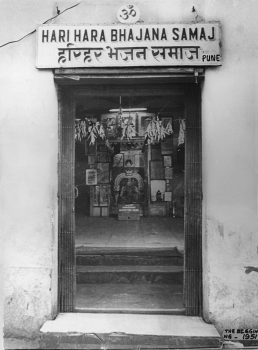
Apparently, the venue was finalised just a week or two before the yajna began on December 31, 1951. The very cosmic forces seem to have been at work, because this momentous jnana yajna, the forerunner of many more to come, and which was to eventually burst forth and grow into the huge tree of Chinmaya Mission, was blessed by Lord Ganesha and held in His own temple in Rastha Peth. This small temple built by Sri Harihara Bhajana Samajam is still there, a place of pilgrimage for staunch devotees of Pujya Gurudev.
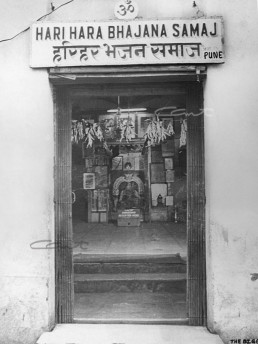

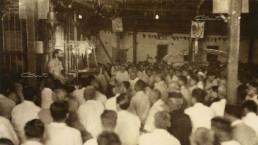

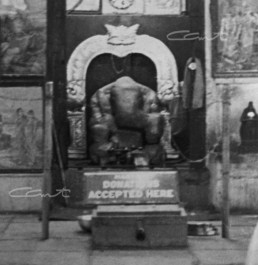

THE GLORIOUS SUCCESS OF THE YAJNA

“On the opening day in Poona, I had an audience of 18 to address …” writes Pujya Gurudev in ‘The Genesis’. The talks were held in the small premises of the temple, but very soon the word spread and more people started pouring in, necessitating arrangements to seat people outside the temple as well. A permanent microphone was fixed. The crowd swelled to about 400-500 in the first month itself. Anyone who came even once was mesmerized and became a regular listener.
The morning classes from 6 to 7 a.m., where Gurudev explained the Shankara Bhashyam, also attracted a good number of people. The Yajnashala report says: “Sree Swamiji is compelled to drop the old orthodox way of Upanishad study and give more and more general discussions in the morning classes also.”
Sri Naidu was a teenager when he entered the Ganesh temple that evening to get Prasad as usual. He was surprised to see a tall slender figure giving a discourse in English.
CHINMAYA’S PRAYER TO HIS GURU
A recently discovered letter by Pujya Gurudev reveals a very moving poem addressed to his Guru, Swami Tapovanam, on the occasion of the Guru Purnima in 1968. Having attained supreme Bliss with the guidance of his Guru, he yearns to pass it on to others. It is this yearning which led him to start the first jnana yajna.
PUJYA GURUDEV ARRIVES IN PUNE
It was a small step from the train to the railway platform, but a momentous and historic event in the annals of Chinmaya Mission, when Pujya Gurudev Swami Chinmayananda stepped out of the train on 23rd of December 1951 and set foot on the punya bhumi (holy land) of Pune. He was received by a big gathering of the important citizens of the city, headed by the Yajna Committee, with Vedic chants and purna kumbham. He had arrived with the whole-hearted blessings of Swami Sivananda and the reluctant blessings of Swami Tapovan Maharaj.
LECTURES HERALDING THE YAJNA
A lot of work had already been done to create public awareness through newspapers, pamphlets, letters and by word of mouth. All these culminated in a series of public lectures in Pune in the week before the inauguration of the yajna. On the 23rd, Swamiji delivered a lecture on the topic ‘Let Us be Hindus’. He talked on ‘What is Religion’ in the Deccan College Estate on the 25th and on ‘Vedanta – The Religion of Detachment’ on the 26th in yet another venue. On the 30th, in the Kirkee branch of the Divine Life Society, he lectured on ‘Our Relationship with the Absolute’. The gist of these talks were published in the form of articles in the very first yajna prasad booklet that was brought out. Except for the first of these, which can be seen below, all the others were included as a part of the introduction to the commentary on Kenopanishad, compiled from the yajna prasad booklets, available as a book today.
BIRTH OF THE JNANA YAJNA
In those days, yajna meant the long traditional havans, the elaborate fire rituals, and yajna prasad meant either the edible offerings sanctified in the ritual or the residual ashes of the fire itself. In this epoch-making event, Pujya Gurudev transformed the whole thing and raised it to a different plane altogether. Taking the cue from the Bhagavad Gita which mentions it, he brought alive the jnana yajna, where the fire of spiritual knowledge is kindled and our primal ignorance burnt forever. And the gist of the talks in printed form was offered as yajna prasad. The true prasad would be the knowledge, peace and bliss that descends on the heart of the devotee.
IMPORTANCE OF YAJNA PRASAD
“Upanishad Yagna, lectures and pamphlet distribution – immediate reproduction of the lecture – this is a unique feature – unprecedented in the annals of Indian history. May Lord bless you all.” Thus wrote Swami Sivananda Maharaj from Rishikesh on February 1st. Gurudev had planned it all beforehand.
Pujya Gurudev sent the first copy of the first yajna prasad to his own Guru, Swami Tapovan Maharaj, in Uttarkashi, with the message, “Thy Knowledge Broadcasted through Thy own Voice-box”, signed Chinmaya. He was merely the instrument to spread the vital message of Vedanta. This first copy is preserved carefully in Chinmaya Archives. A total of six numbers on Kenopanishad were published at this time.
THE YAJNASHALA
Apparently, the venue was finalised just a week or two before the yajna began on December 31, 1951. The very cosmic forces seem to have been at work, because this momentous jnana yajna, the forerunner of many more to come, and which was to eventually burst forth and grow into the huge tree of Chinmaya Mission, was blessed by Lord Ganesha and held in His own temple in Rastha Peth. This small temple built by Sri Harihara Bhajana Samajam is still there, a place of pilgrimage for staunch devotees of Pujya Gurudev.

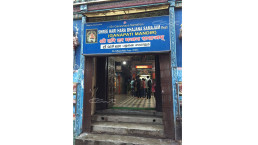


The Glorious Success of the Yajna
“On the opening day in Poona, I had an audience of 18 to address …” writes Pujya Gurudev in ‘The Genesis’. The talks were held in the small premises of the temple, but very soon the word spread and more people started pouring in, necessitating arrangements to seat people outside the temple as well. A permanent microphone was fixed. The crowd swelled to about 400-500 in the first month itself. Anyone who came even once was mesmerized and became a regular listener.
The morning classes from 6 to 7 a.m., where Gurudev explained the Shankara Bhashyam, also attracted a good number of people. The Yajnashala report says: “Sree Swamiji is compelled to drop the old orthodox way of Upanishad study and give more and more general discussions in the morning classes also.”


